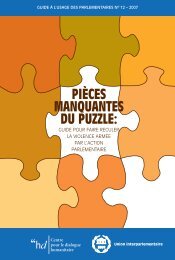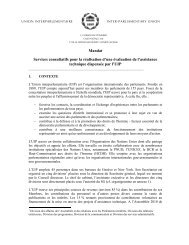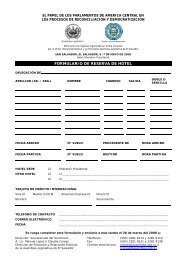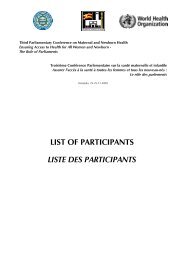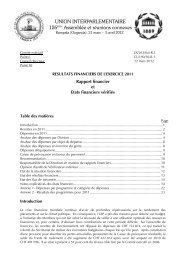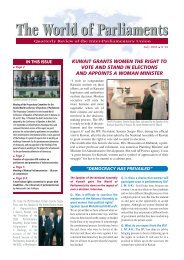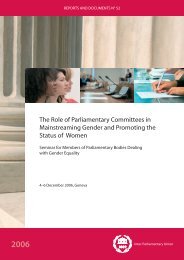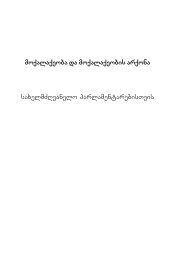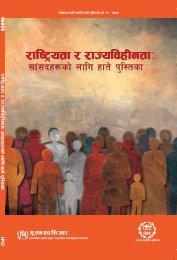MISSING PIECES - Inter-Parliamentary Union
MISSING PIECES - Inter-Parliamentary Union
MISSING PIECES - Inter-Parliamentary Union
Create successful ePaper yourself
Turn your PDF publications into a flip-book with our unique Google optimized e-Paper software.
<strong>MISSING</strong> <strong>PIECES</strong><br />
public health approach to gun violence includes isolating and controlling<br />
the cause of injury—in this case, small arms.<br />
The relationship between gun ownership and gun death is complex. As<br />
with any social policy issue, proving a causal relationship between widespread<br />
weapons availability and gun violence is difficult, hampered by a<br />
lack of complete and reliable data and an inability to screen out mitigating<br />
factors. 16 On balance, however, empirical evidence supports the notion that<br />
making guns more difficult to obtain legally can help reduce certain types<br />
of violence, particularly those that are impulsive. 17 In particular, the presence<br />
of guns in the home has been shown to influence rates of suicide,<br />
accidents, intimate partner violence, and family murders. 18<br />
BOX 1 PREVENTING SUICIDE: FOCUSING ON THE GUN<br />
The social stigma often attached to self-directed violence means that gun<br />
suicides are largely neglected—or sidelined—in efforts to prevent armed<br />
violence. In fact, the magnitude and patterns of gun suicide provide a compelling<br />
supporting case for improved small arms controls.<br />
Suicide—a global health burden<br />
An estimated 815,000 people commit suicide each year, 19 of which at least<br />
50,000 (6 per cent) are completed with small arms, 20 compared to about<br />
200,000 global gun homicides. 21 Gun suicides represent 1.4 per cent of the<br />
Global Burden of Disease, 22 but this burden is distributed unevenly across<br />
regions: almost half (48 per cent) of all suicides with small arms occur in<br />
Western Europe and North America. In the US, the gun suicide rate is ten<br />
times that of Africa and Southeast Asia. 23 However, suicides are often underreported<br />
in the global South for religious or cultural reasons, so the true<br />
firearm suicide rate may be much higher. 24 In Brazil, for example, public<br />
health experts believe that many gun deaths ruled by coroners to be of<br />
‘unknown cause or intent’ are actually suicides. 25<br />
The suicidal urge is commonly impulsive and transitory, especially in<br />
youth, and many people who contemplate or attempt suicide eventually<br />
recover and lead healthy, fulfilled lives. But if a gun is available to use in a<br />
suicide attempt, the chances of survival are slim: 85 per cent of suicide<br />
attempts with a gun end in death, a higher completion rate than by other<br />
methods, such as jumping, laceration, and poison. 26 Those who do survive<br />
self-directed gunshots often suffer life-long head injuries that present a<br />
‘formidable challenge to reconstructive surgeons’ 27 with significant social<br />
and psychological repercussions for the injured.<br />
Unlike firearm homicides, which are primarily—but by no means exclusively—an<br />
urban and outdoor phenomenon, gun suicides routinely occur<br />
in the home and in rural settings. 28 In the US, rural communities experience<br />
a 54 per cent higher firearm suicide rate than urban communities. In England<br />
18



